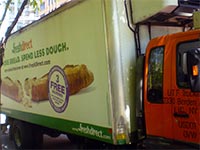On my way home I passed a Fresh Direct truck.
For years, I’ve considered it an extravagance. In my area there are a couple of supermarkets, dozens of smaller shops and a Target, all within a short drive. How lazy could my neighbors be?!
It turns out, they were the smart ones.
As this story over at NPR shows, ordering from home delivery services like the aforementioned Fresh Direct, Peapod or Amazon Fresh (currently only in the Seattle area) is a lot greener than schlepping all over town to knock the groceries off your list.
A new study co-authored by Anne Goodchild, an assistant professor of engineering at the University of Washington, shows that since groceries get a “shared ride” in delivery trucks, having them dropped off at your door is more efficient than hopping in your car and fetching them yourself.
Home food delivery trucks, they found, produce 20 to 75 percent less carbon dioxide than having the same households drive to the store. The variation is based on how close people live to the store, the number of people in the neighborhood getting food delivered and the efficiency of the truck’s route.
Combining errands — say, stopping at the store on the way home from work — doesn’t cut the sole shopper’s carbon footprint much, Goodchild says, because shared transport is so much more efficient.
So if I sign up for Fresh Direct, it’s not because I’m lazy, but because I’m eco-conscious!


Leave a Reply